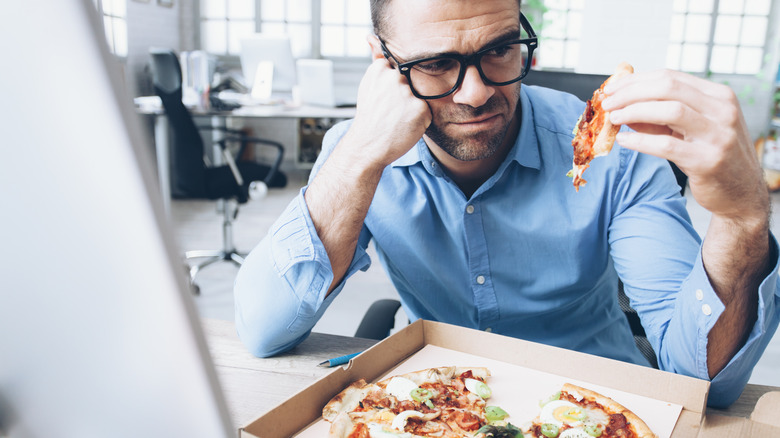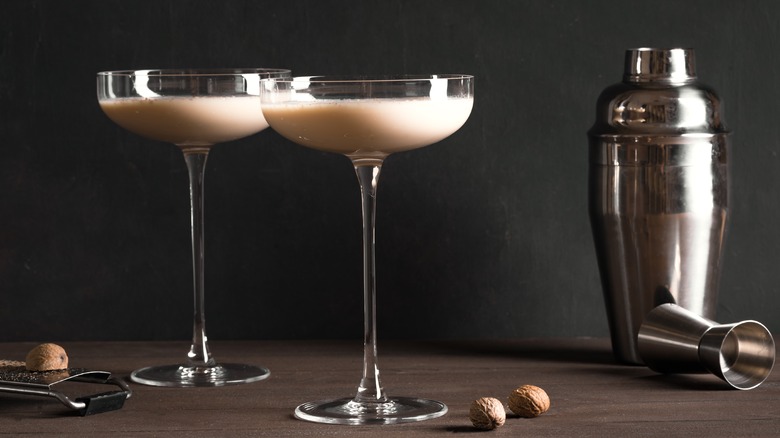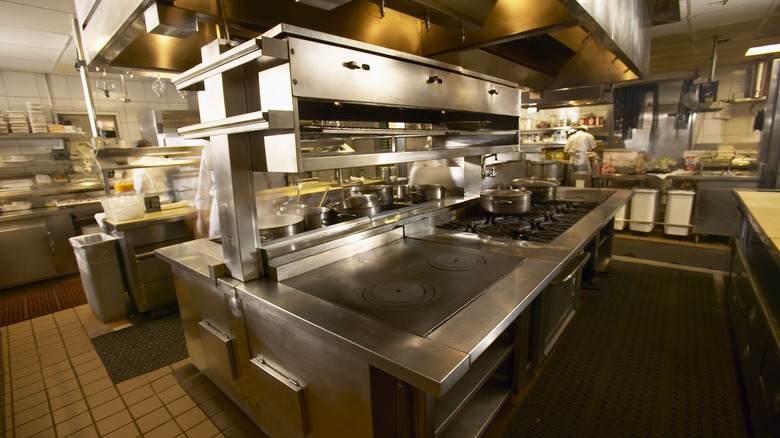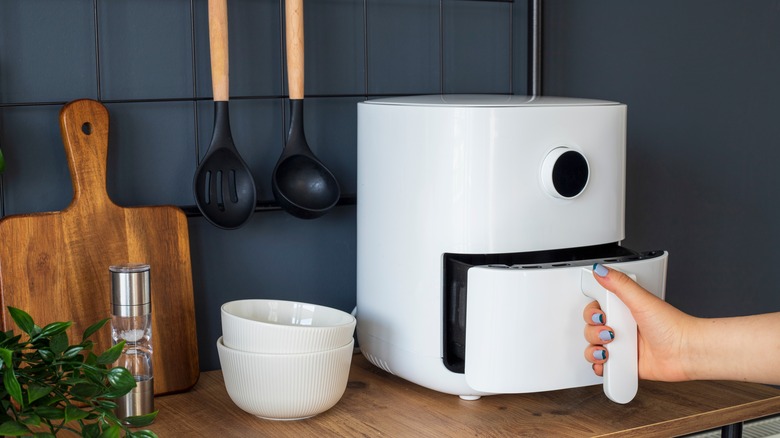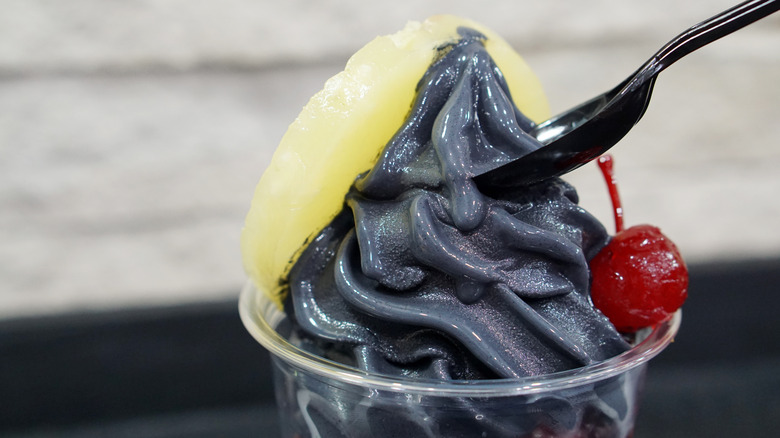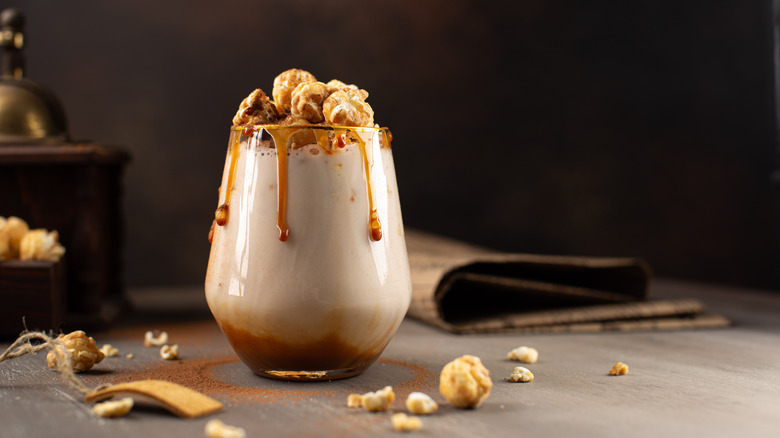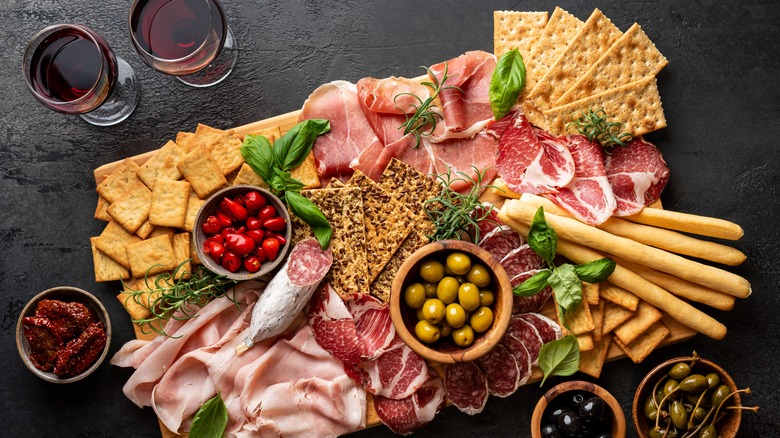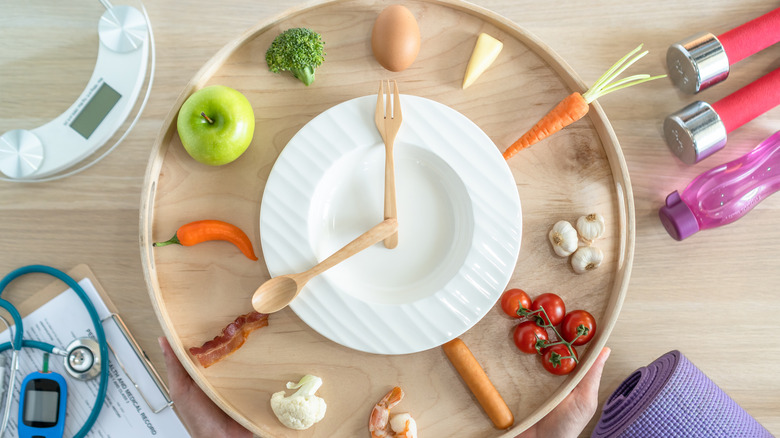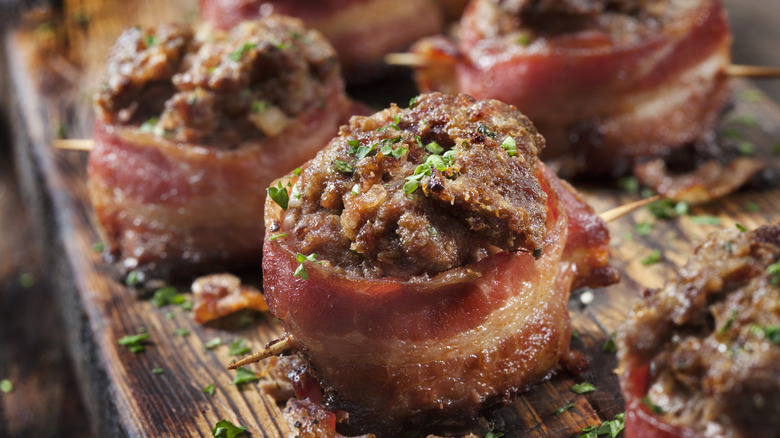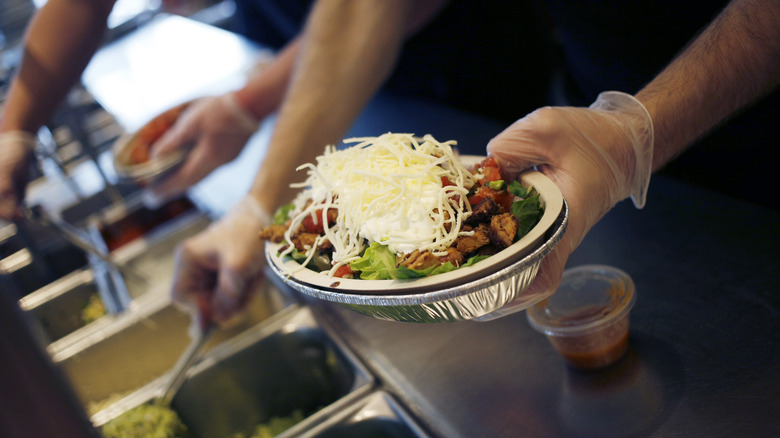Food Trends We're Seriously Sick Of And Ready To Kick To The Curb
Listen, we're not anti-food trend here at Mashed. We love all most things food. From haute cuisine dished up by celebrity chefs that looks more like a museum piece than a dinner plate to out-of-this-world fast food nonsense (looking at you, Grimace shake), we're all about food going viral. While there are certain food trends we fully expect to be embraced by the public — and often for good reason — there are other food trends we'd prefer to leave behind.
The reasons why a food trend wears out its welcome can be as varied as the TikTok videos that ushered in its arrival in the first place. Sometimes, it's simply a matter of social media overkill. Other times, people simply realize that maybe pickle milkshakes don't need to be a thing — like, ever. Nevertheless, there are a few food trends floating around out there that the Mashed writing team feels have no business hanging around in 2024.
The eggnog beverage blow-up - Ellie Barbee
Who says eggnog — the thick, creamy, dairy-based beverage calling for both raw egg yolks and whites that some love and others avoid like the plague — needs to be added to every single drinkable thing during the holidays? I know I can't be the only one who finds the idea of spiking every single latte, cold brew, cocktail, hot tea, and bowl of punch under the sun with liquid eggs unappetizing and excessive.
Sure, the mixture has its place and time. The occasional throwing together of a classic, cinnamon-and-nutmeg eggnog-based beverage while snuggling by a warm fire is hardly a criminal offense — but it feels as though things have gotten out of hand. I mean, seriously, eggnog with matcha? Orange soda and eggnog? Eggnog-and-red wine mashups? Just because you can, doesn't always mean you should — and at some point, someone's got to put their foot down and say that our taste buds have had enough of consuming bizarre curdled egg concoctions.
Ghost kitchens - Crysta Coburn
Virtual restaurants, cloud kitchens, ghost kitchens. Call them what you will. I call them devious. I am all for supporting a local start-up restaurateur looking to launch a new local business. If only I could be assured that is what is going on with the new delivery-only restaurant that popped up in GrubHub with an address that sounds suspiciously familiar. Too often, people who are looking to support a local business are fooled by a ghost kitchen that is, in fact, operated by large chains like Applebee's, Denny's, TGI Friday's, or even Chuck E. Cheese!
Sometimes, multiple delivery-only restaurants are operating under multiple names out of the same industrial kitchen. There is no sign out front advertising the restaurant to draw in patrons. These virtual restaurants operate exclusively through delivery apps. Dozens of restaurants could be working out of the same address, all "specializing" in different foods, like tacos or chicken wings, and cuisines, such as Chinese or Italian. The same item might even appear on multiple menus.
If we can't kick all ghost kitchens to the curb, we at least need more transparency in this area. These ghost kitchens are in direct competition with legitimate local restaurants owned by people in the community. I would much rather support my neighbors than a chain or anonymous industry kitchen in a mask, and I don't think I'm alone here.
Air frying everything - Helena Nichols
Frying just about anything makes it better. But air frying isn't frying; it is just convection baking. Air fryers work by circulating hot air around the basket. The holes at the bottom of the air fryer allow the air to touch the food's top and bottom while cooking. This creates an even, crisp, and browned exterior with little to no oil. While this is great for many uses — but this is not new technology. Many ovens and toasters come with a convection setting. We don't need one more bulk countertop appliance to do the thing that can be done by something else. During a recent kitchen remodel, multiple people told me to get an air fryer and then proceeded to list every food in the world that can be made with one. All of these can be made in the toaster oven I've had for the past 10 years.
Plus, let's face it, air frying just doesn't give the same delicious, perfectly greasy, crispy result that frying does because it is not frying it; it is baking. Baked food is excellent, but let's not lie about what it is. Additionally, air fryers are notoriously tricky to clean properly. Sure, you can buy liners, but many have solid bottoms, blocking airflow and turning your air fryer back into a standard toaster oven.
Can we please return to frying foods we want to fry, convection baking foods we want to be baked, and kick this overpriced unitasker to the curb?
Charcoal-flavored food and drinks - Mary K. Cahill
We've all been guilty of snapping food and drink photos for the 'gram, and activated charcoal has added some dark beauty to the feed in the last few years. However, it's getting old now, and like fondant, charcoal foods (especially desserts) look prettier than they taste. Honestly, have you ever heard anyone say their favorite flavor is ash? According to Very Well Health, charcoal-hued foods you'll come across contain activated charcoal, a mild-flavored, finely ground powder made from coal, peat, coconut shells, wood, petroleum, or some combination thereof. Activated charcoal touts medical benefits, however, consuming it regularly can do stuff to your body that isn't all that healthy.
Charcoal becomes activated when heated at very high temperatures in an oxygen-less environment (like a tank). When activated, the charcoal's chemical structure becomes extremely porous, which allows it to bind to other substances and promotes a detoxifying quality. This is why activated charcoal has long been used in the medical field to counteract drug overdoses or chemical poisoning. I love the thought of detoxing our bodies with an ice cream cone or iced latte as much as you do, but there's a problem. Charcoal can also absorb things we do want in our bodies, like vitamins, minerals, and prescription medication. Combined with complimentary flavors like coconut or almond, charcoal seems more palatable, and the contrast of that deep, luxuriant gray against a shock of rainbow sprinkles looked cool the first thousand times — but in 2024, this food trend has lost my interest.
Food-flavored coffee - Lily McElveen
We live in a golden age of coffee, a time when you can stroll down the street of any major city and find a coffee shop serving not just cups of caffeine to get you through the morning but a range of beverages made from carefully sourced beans that are expertly roasted and brewed. Insufferable snobbishness notwithstanding, plain coffee beans are bursting with flavor all by themselves. Each stage of production affects their flavor, from the elevation at which they're grown to how they're processed and how they're roasted. You might see coffee beans advertised as having acidic berry notes or smooth chocolatey ones, all of which are achieved with no additional ingredients.
In this light, the constant one-upmanship of brands selling artificially flavored coffee is maddening. The market is so out of control that you can buy products that supposedly taste like peanut butter and jelly sandwiches, cotton candy, and tacos. And that doesn't even include Frappuccinos. The shady truth about flavored coffee is probably something people know in their hearts but don't want to think about: that doughnut-flavored latte is not really made with doughnuts. It's made in a lab with dozens of chemicals, syrups, and solvents, and manufacturers often take advantage of these powerful concoctions to mask low-quality beans. At this point, we'd all be better off if brands just made those actual foods and flavored them with coffee instead of the other way around.
Bored with boards - Steve Luna
Haven't we experienced enough decorative food boards to last a lifetime by now? It wasn't enough for cheese plates to become charcuterie boards; there had to be dessert boards, frosting boards, and butter boards, too. It seems like no food is safe from the potential influence of board-dom, not even spreadable items that belong in dishes have been spared being slathered across a serving tray. It doesn't seem to matter that it gets less appetizing — and more exposed to cross-contamination — with every swipe. It looks cool, so it caught on. But now, it can catch off.
Sure, it's been fun to see these Instagrammable displays blow up. There's a lot of imagination being spent on making party snacks look like edible art. But it's time to put food back on plates and let the flavor be what dazzles, not the layout. There's only so much you can do with snacks to turn them into eye-catching decor, anyway (let's not even start on those bizarre butter and cheese candles). We've seen just about everything there is to see with this tired trend by now. It's time to give a new food fad a chance at the limelight.
What I eat in a day videos - Ivana Maric
If you are not familiar with the idea of "What I eat in a day" videos, they are best described as short video clips in which influencers, celebrities, and content creators share everything they eat in a day, including all major meals, snacks, and drinks. At first, these shorts and their longer YouTube counterparts covering weekly eating habits seemed fun and relaxing. They gave an additional glimpse into the private lives of some of our favorite social media people and were somewhat positive and inspirational, influencing us to be more creative in the kitchen and to plan our meals to avoid those gnarly takeout orders that are often the last resort during busy weekdays. However, at one point, the idea intended as sheer entertainment crossed the line and became one more piece of the calorie-obsessed society puzzle.
These days, "What I eat in a day" videos seem to act as a platform to promote unrealistic eating habits. They mainly focus on wholesome, vegan, or protein-laden meals and often list the calories and portion sizes. These videos are no longer intended as inspirational or practical. In many cases, they make you feel anxious and self-conscious about your daily eating habits. As it's a trend that has long lost its original purpose, we're fine with leaving this one behind and focusing on food content that adds value to our lives instead of promoting unhealthy, restrictive, and unsustainable trends.
Bacon everything - Kirstie Renae
Let's get one thing out of the way — I'm not anti-bacon. I love bacon and its salty, savory, melt-in-your-mouth, and crunchy qualities just as much as the next person. But I do feel we've taken bacon a bit too far. It wasn't until I started trying out new restaurants with my vegetarian mother-in-law that I realized just how often bacon is added to dishes without cause. When we dine out at new spots together, we like to split everything we order so we can get a taste of as many dishes as possible. And yet, despite picking things like vegetable side dishes, pasta dishes, and soups, it almost always seems like we have to order things without the bacon to make it vegetarian for her.
Soon I noticed that there were very few trendy new appetizers, entrees, and yes, desserts, recommended to me on the cooking side of TikTok without the presence of bacon. Bacon can be a delightful umami bomb to meals, but I don't think it belongs in everything. I'm not interested in a donut with crispy bacon bits on it. I don't want to see another dip recipe for the big game filled with bacon. And I think adding bacon to cream sauces for pasta is just too heavy-handed when it comes to sodium and fat. Bacon flavor can be overpowering, and I'd like to see the trend of adding it to absolutely everything die down a bit.
Bland bowls - Crawford Smith
It's time to address the scourge of the modern fast-casual dining scene: bowls. Of course, there's nothing inherently wrong with the idea of serving a mix of ingredients together in a bowl; from Korean bibimbap to Japanese donburi, plenty of cultures have dishes that follow the "protein + vegetables + starch = good" formula.
However, most of the bowls sold in America are profoundly disappointing. While traditional bowl dishes are carefully calibrated to provide a mix of flavors and textures, fast-casual bowls are just a bland mess. Popular bowl destinations like Chipotle and poke chains typically serve neutered, flavorless versions of vibrant international cuisines. Do you like the idea of a contrast of mouthfeels and textures in each bite? Too bad, because after a couple of minutes under a plastic lid, the salad in your bowl is as warm and limp as the meat is tepid and wet.
Ultimately, bowls make more sense as a signifier of the grim optimization of the modern era than as a fun idea for a meal. They're built by mindlessly scooping slop from a steam table into a disposable container. They can then be shoveled equally as mindlessly into your mouth as your eyes glaze over during a desk lunch, or you sit in traffic during your commute. Food should be an event, a moment in your day when you celebrate Earth's bounty. If you're fueling up on bland bowls, why not just cut out the middleman and subsist on meal replacement shakes?
